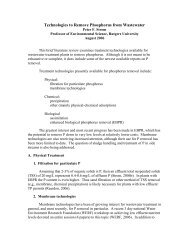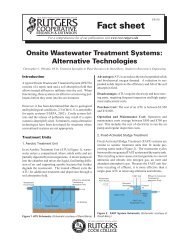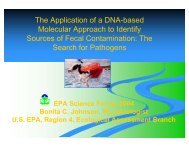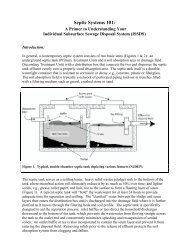Development of a PCR Assay for Rapid Detection of Enterococci
Development of a PCR Assay for Rapid Detection of Enterococci
Development of a PCR Assay for Rapid Detection of Enterococci
You also want an ePaper? Increase the reach of your titles
YUMPU automatically turns print PDFs into web optimized ePapers that Google loves.
VOL. 37, 1999 RAPID DETECTION OF ENTEROCOCCI 3501TABLE 5. <strong>Detection</strong> limits <strong>of</strong> the Enterococcus-specific <strong>PCR</strong> assays<strong>for</strong> 14 enterococcal species<strong>Detection</strong> limit (no. <strong>of</strong> genomes)<strong>for</strong> <strong>PCR</strong> with the followingSpeciesno. <strong>of</strong> cycles a :30 40E. avium 1,700 8E. cecorum 1,700 2E. casseliflavus b 670 4E. dispar ND 8E. durans 330 4E. faecalis 670 2E. faecium 670 8E. flavescens b ND 8E. gallinarum 330 8E. hirae 330 4E. mundtii 1,700 8E. pseudoavium 330 2E. raffinosus 1,700 8E. saccharolyticus 330 2a The genome size <strong>for</strong> all enterococcal species was considered the same as that<strong>of</strong> E. faecalis (3.0 Mb). Serial tw<strong>of</strong>old dilutions <strong>of</strong> genomic DNA from eachenterococcal species were tested to determine the detection limit <strong>of</strong> the assay <strong>for</strong>each species. ND, not determined.b E. casseliflavus and E. flavescens are now considered the same species (33).among different genera (38), the inability to detect enterococcipromptly may cause delays in reporting VRE; this situationmay lead to complex and costly containment ef<strong>for</strong>ts to eliminateVRE colonization and infection.The development <strong>of</strong> rapid and sensitive DNA-based assayswhich are applicable <strong>for</strong> the direct detection <strong>of</strong> enterococcifrom clinical specimens may improve the rapidity and the accuracy<strong>of</strong> the diagnosis <strong>of</strong> enterococcal infections. The validityand versatility <strong>of</strong> <strong>PCR</strong> in applications <strong>for</strong> the detection <strong>of</strong>nucleic acids from a variety <strong>of</strong> infectious agents have been wellreviewed by Whelen and Persing (36). In the present study, wehave developed a rapid <strong>PCR</strong>-based assay to improve the diagnosis<strong>of</strong> enterococcal infections. Initially, <strong>PCR</strong> primers complementaryto highly conserved regions <strong>of</strong> the tuf gene amongeubacteria were designed and used to amplify an 803-bp portion<strong>of</strong> the tuf gene from 14 enterococcal species. By sequencingfour enterococcal species, which represented four differententerococcal subgroups based on 16S rRNA gene analysis, wehave obtained adequate sequence in<strong>for</strong>mation to design a pair<strong>of</strong> Enterococcus-specific <strong>PCR</strong> primers. Subsequently, a <strong>PCR</strong>basedassay was set up and optimized to be simple and rapid.Among 50 species <strong>of</strong> gram-positive (representing 9 genera)and 44 species <strong>of</strong> gram-negative (representing 21 genera) clinicallyimportant bacteria tested, this <strong>PCR</strong>-based assay was ableto detect all enterococcal species tested, except <strong>for</strong> E. solitarius,which in fact does not appear to be a member <strong>of</strong> the genusEnterococcus based on a phylogenetic analysis (25, 37). TwoAbiotrophia species were also amplified efficiently under thesame amplification conditions. Moreover, amplification <strong>of</strong> fourListeria species was also observed when the number <strong>of</strong> <strong>PCR</strong>cycles was increased from 30 to 40. It should be noted thatDNA from Listeria species was amplified about 100 times lessefficiently than enterococcal DNA. However, most clinicallyimportant bacteria can be easily differentiated from enterococciby this assay, indicating its usefulness <strong>for</strong> the detection <strong>of</strong>enterococci. The concomitant use <strong>of</strong> species-specific internalprobes should allow exclusion <strong>of</strong> Abiotrophia and Listeria speciesby increasing the specificity <strong>of</strong> the Enterococcus-specific<strong>PCR</strong>-based assay.To elucidate the fact that the developed <strong>PCR</strong>-based assayfailed to detect E. solitarius, which rarely causes infections inhumans, we amplified and sequenced an 890-bp portion <strong>of</strong> tufencompassing the 803-bp region by using another pair <strong>of</strong> primers(unpublished data). The sequence similarity between E.solitarius and other enterococci ranged from 79 to 81%, whilethat between the other enterococci ranged from 89 to 91%.This finding supports 16S rRNA data reported by others (25,37) suggesting that E. solitarius is not a member <strong>of</strong> the genusEnterococcus (93.0 to 94.8% homology) but is phylogeneticallymore closely related to the genus Tetragenococcus (97.8% homology).Sequence data revealed that there were six mismatchesat the Enterococcus-specific 3-primer binding sitewhich led to a failure in the amplification <strong>of</strong> E. solitarius by thedeveloped <strong>PCR</strong>-based assay.The finding that A. adiacens and A. defectiva, <strong>for</strong>merly referredto as nutritionally variant streptococci (17), were alsopositive in our Enterococcus-specific <strong>PCR</strong> assay indicates ahigh level <strong>of</strong> similarity <strong>of</strong> the tuf genes at the primer bindingsites in the genus Abiotrophia and the genus Enterococcus.Sequencing <strong>of</strong> the 803-bp region <strong>of</strong> tuf showed that the sequencesimilarities between the enterococcal and Abiotrophiaspp. ranged from 85 to 89%, values which are quite high. Forcomparison, the tuf sequences among enterococci are 89 to91% similar. There<strong>for</strong>e, it is not surprising that <strong>PCR</strong> primersderived from the tuf sequence amplify DNA from Abiotrophiaspp. as well. In fact, there are only two mismatches at the 5end <strong>of</strong> the Enterococcus-specific primers compared to the sequences<strong>of</strong> A. defectiva and A. adiacens. Consequently, thesensitivity level achieved <strong>for</strong> the two Abiotrophia species wassimilar to that obtained <strong>for</strong> the enterococcal species. In addition,several Listeria species were detectable when 40-cycle<strong>PCR</strong> was per<strong>for</strong>med, even though three mismatches locatednear the 3 end <strong>of</strong> the upper primer were found between thefour Listeria species and enterococci. However, it should benoted that Listeria DNA was amplified approximately 100times less efficiently than enterococcal DNA. The four Listeriaspecies, L. monocytogenes, L. innocua, L. ivanovii, and L.seelegeri, showed sequence similarities to enterococci rangingfrom 82 to 83% (data not shown). Based on the level <strong>of</strong> sequencedivergence <strong>for</strong> the tuf gene, it should be possible todevelop enterococcal species-specific internal probes which allowdiscrimination <strong>of</strong> members <strong>of</strong> the genera Abiotrophia andListeria from those <strong>of</strong> the genus Enterococcus.Others have developed E. faecalis-specific and E. faeciumspecific<strong>PCR</strong>-based assays by targeting various genes. The targetgenes include (i) ddl (coding <strong>for</strong> D-alanine-D-alanine ligase)<strong>for</strong> the species-specific detection <strong>of</strong> E. faecalis and E. faecium(10, 30) and (ii) PBP5 (coding <strong>for</strong> penicillin binding protein)<strong>for</strong> the species-specific detection <strong>of</strong> E. faecalis (27). A <strong>PCR</strong>basedassay amplifying different vanC genes (coding <strong>for</strong> intrinsicvancomycin resistance in E. gallinarum, E. casseliflavus, andE. flavescens) has also been developed to specifically detect E.gallinarum, E. casseliflavus, and E. flavescens (10). A sequence<strong>of</strong> unknown coding potential, selected from an E. faeciumgenomic library, has been used to develop an E. faeciumspecific<strong>PCR</strong>-based assay (5). Although E. faecalis and E. faeciumaccount <strong>for</strong> a majority <strong>of</strong> enterococcal infections, otherenterococci may be associated with infections. However, currentlyavailable systems based on culturing <strong>for</strong> the identification<strong>of</strong> gram-positive cocci are <strong>of</strong>ten unable to correctly identifythese less frequently encountered enterococci (29, 32, 34).Tyrrell et al. (35) reported using an internally transcribedspacer region <strong>PCR</strong> to identify enterococcal species based oncharacteristic amplicon pr<strong>of</strong>iles and the different patterns <strong>of</strong>Sau3A-digested <strong>PCR</strong> amplicons. Donabedian et al. (9) dem-
3502 KE ET AL. J. CLIN. MICROBIOL.onstrated that contour-clamped homogeneous electric fieldelectrophoresis patterns and DNA-DNA hybridization withbiotin-labeled genomic DNAs from type strains <strong>of</strong> enterococciused as probes may be suitable <strong>for</strong> species differentiation <strong>of</strong>some enterococci. However, neither method is feasible <strong>for</strong>routine use in the clinical laboratory because <strong>of</strong> high complexityand must be used in conjunction with phenotypic tests toprovide reliable results (9, 35). Recently, Quednau et al. (26)and Monstein et al. (23) identified enterococci to the species orspecies group level by using randomly amplified polymorphicDNA methods. A simple test <strong>for</strong> the detection <strong>of</strong> Enterococcusspp. has been developed by Gen-Probe <strong>for</strong> use as a cultureconfirmation assay; this test was 100% accurate in identifyingenterococcal isolates from cultures by hybridization to rRNA(6). However, this assay does not <strong>of</strong>fer potential <strong>for</strong> enterococcalspecies identification. Moreover, the sensitivity <strong>of</strong> the Gen-Probe assay is not sufficient <strong>for</strong> direct detection <strong>of</strong> enterococcifrom clinical specimens.Besides identification <strong>of</strong> bacterial species by species-specific<strong>PCR</strong>-based assays, identification may also be per<strong>for</strong>med bycoupling the amplification <strong>of</strong> a highly conserved gene withhybridization to internal probes or DNA sequencing (1, 14, 20,22). Many conserved genes have been selected as targets <strong>for</strong>this purpose. Among them, the 16S rRNA gene has been usedto detect a wide variety <strong>of</strong> eubacteria because the presence <strong>of</strong>conserved regions and variable regions in this gene providesthe possibility <strong>of</strong> developing <strong>PCR</strong>-based assays suitable <strong>for</strong>detecting and identifying bacteria at the species level or highertaxonomic levels (22). Other genes have been exploited <strong>for</strong>similar purposes. The sod gene, coding <strong>for</strong> superoxide dismutase,has been used as a target to amplify 28 species <strong>of</strong>mycobacteria and to differentiate one from another withprobes recognizing species-specific regions (39). A similar approachhas been used <strong>for</strong> the detection <strong>of</strong> staphylococci bytargeting the chaperonin 60 (cpn60) gene (13, 14). These methodsare specific, but their sensitivity remains unclear. Thelatter is critical when such tests are used to detect bacteriadirectly from clinical specimens. Berg et al. (1) have developeda <strong>PCR</strong>-based detection system <strong>for</strong> M. fermentans by targetingthe tuf gene; the system has a high sensitivity. A similarassay has also been used <strong>for</strong> the identification <strong>of</strong> M. pneumoniae(20).The tuf gene acts in translation to bring aminoacylatedtRNA molecules to the ribosome. This gene represents anideal candidate target <strong>for</strong> diagnostic purposes because it ishighly conserved at the nucleotide level and ubiquitous inbacteria. By analyzing a rather small tuf sequence data setavailable in public databases, we were able to design <strong>PCR</strong>primers which could amplify an 803-bp portion <strong>of</strong> the tuf genefrom a variety <strong>of</strong> bacteria, including members <strong>of</strong> the generaEnterococcus, Streptococcus, and Staphylococcus. We foundthat there were more nucleotide sequence variations in the tufgene sequences than in the corresponding 16S rRNA genesequences <strong>for</strong> four enterococcal species (i.e., E. faecalis, E.faecium, E. avium, and E. gallinarum). An analysis <strong>of</strong> the tufsequences from gram-positive bacteria allowed the development<strong>of</strong> a <strong>PCR</strong>-based assay amplifying 14 <strong>of</strong> 15 enterococcalspecies tested. The <strong>PCR</strong>-based assay described here differentiatesenterococci from most clinically relevant bacteria, indicatingthat the tuf gene is a target <strong>of</strong> choice <strong>for</strong> the moleculardetection <strong>of</strong> enterococci. Furthermore, the amplicon sequencepolymorphism should be sufficient to provide discriminatoryinternal probes specific <strong>for</strong> clinically important enterococcalspecies. The sensitivity <strong>of</strong> the 30-cycle <strong>PCR</strong>-based assay variesfrom 330 to 1,700 copies <strong>of</strong> enterococcal genomes <strong>for</strong> the 14enterococcal species detected. This sensitivity level is sufficient<strong>for</strong> culture confirmation assays. It is possible to efficiently increasethe sensitivity <strong>of</strong> the assay. For example, in sensitivityassays per<strong>for</strong>med with 40-cycle <strong>PCR</strong>, the detection limit wasreduced to about two to eight copies <strong>of</strong> enterococcal genomes<strong>for</strong> the same 14 enterococcal species. This sensitivity levelshould be sufficient <strong>for</strong> the direct detection <strong>of</strong> enterococci inclinical specimens, such as fecal or urine samples. The use <strong>of</strong>this <strong>PCR</strong>-based assay coupled with species-specific internalprobes specific <strong>for</strong> clinically important enterococci and other<strong>PCR</strong> assays targeting vancomycin resistance genes should providea useful screening test <strong>for</strong> VRE from rectal swabs. Such anassay is currently under development in our laboratory.In conclusion, we have developed a <strong>PCR</strong>-based diagnosticassay which is simple to conduct and reliable <strong>for</strong> the detection<strong>of</strong> enterococci. This assay <strong>of</strong>fers an alternative to currentlyused methods and should allow the identification <strong>of</strong> clinicallyimportant enterococcal species if coupled with species-specificprobes complementary to internal regions <strong>of</strong> the amplicons.This new diagnostic tool may lead to the early diagnosis <strong>of</strong>enterococcal infections, which is essential <strong>for</strong> the preventionand control <strong>of</strong> transmission <strong>of</strong> the infections.ACKNOWLEDGMENTSWe thank Louise Coté, director <strong>of</strong> the microbiology laboratory <strong>of</strong>CHUQ, Pavillon CHUL, <strong>for</strong> free access to the laboratory and <strong>for</strong>providing enterococcal and other clinical isolates. We thank Jean-LucSimard, Martin Gagnon, Marie-Josée Boily, Caroline Paquet, NicolasLansac, Marie-Claude Bergeron, and Gisèle Chassé <strong>for</strong> help. We alsothank Louise Jetté (Laboratoire de Santé Publique du Québec),Donald E. Low (Mount Sinai Hospital), Barbara E. Murray (University<strong>of</strong> Texas, Houston), Fred C. Tenover (Centers <strong>for</strong> Disease Controland Prevention), Wang Fu (Huashan Hospital), and Daniela Centron-Garcia (Universidad de Buenos Aires) <strong>for</strong> providing enterococcalstrains. We thank Maurice Boissinot <strong>for</strong> critical comments regardingthe manuscript.Marc Ouellette is an MRC scientist and a recipient <strong>of</strong> the BurroughsWellcome Fund new investigator award in molecular parasitology.This study was supported by grant PA-15586 from the Medical ResearchCouncil <strong>of</strong> Canada and by Infectio Diagnostic (I.D.I) Inc.,Sainte-Foy, Québec, Canada.REFERENCES1. Berg, S., E. Luneberg, and M. Frosch. 1996. <strong>Development</strong> <strong>of</strong> an amplificationand hybridization assay <strong>for</strong> the specific and sensitive detection <strong>of</strong> Mycoplasmafermentans DNA. Mol. Cell. Probes 10:7–14.2. Bergeron, M. G., and M. Ouellette. 1998. Preventing antibiotic resistancethrough rapid genotypic identification <strong>of</strong> bacteria and <strong>of</strong> their antibioticresistance genes in the clinical microbiology laboratory. J. Clin. Microbiol.36:2169–2172.3. Betzl, D., W. Ludwig, and K. H. Schleifer. 1990. Identification <strong>of</strong> lactococciand enterococci by colony hybridization with 23S rRNA-targeted oligonucleotideprobes. Appl. Environ. Microbiol. 56:2927–2929.4. Centers <strong>for</strong> Disease Control and Prevention. 1993. Nosocomial enterococciresistant to vancomycin—United States, 1989–1993. Morbid. Mortal. WeeklyRep. 42:597–599.5. Cheng, S., F. K. McCleskey, M. J. Gress, J. M. Petroziello, R. Liu, H.Namdari, K. Beninga, A. Salmen, and V. G. Del Vecchio. 1997. A <strong>PCR</strong> assay<strong>for</strong> identification <strong>of</strong> Enterococcus faecium. J. Clin. Microbiol. 35:1248–1250.6. Daly, J. A., N. L. Clifton, K. C. Seskin, and W. M. Gooch. 1991. Use <strong>of</strong> rapid,nonradioactive DNA probes in culture confirmation tests to detect Streptococcusagalactiae, Haemophilus influenzae, and Enterococcus spp. from pediatricpatients with significant infections. J. Clin. Microbiol. 29:80–82.7. Devriese, L. A., B. Pot, and M. D. Collins. 1993. Phenotypic identification <strong>of</strong>the genus Enterococcus and differentiation <strong>of</strong> phylogenetically distinct enterococcalspecies and species groups. J. Appl. Bacteriol. 75:399–408.8. Devriese, L. A., M. Ieven, H. Goossens, P. Vandamme, B. Pot, J. Hommez,and F. Haesebrouck. 1996. Presence <strong>of</strong> vancomycin-resistant enterococci infarm and pet animals. Antimicrob. Agents Chemother. 40:2285–2287.9. Donabedian, S., J. W. Chow, D. M. Shlaes, M. Green, and M. J. Zervos. 1995.DNA hybridization and contour-clamped homogeneous electric field electrophoresis<strong>for</strong> identification <strong>of</strong> enterococci to the species level. J. Clin.Microbiol. 33:141–145.10. Dutka-Malen, S., S. Evers, and P. Courvalin. 1995. <strong>Detection</strong> <strong>of</strong> glycopep-
VOL. 37, 1999 RAPID DETECTION OF ENTEROCOCCI 3503tide resistance genotypes and identification to the species level <strong>of</strong> clinicallyrelevant enterococci by <strong>PCR</strong>. J. Clin. Microbiol. 33:24–27.11. Facklam, R. R., and M. D. Collins. 1989. Identification <strong>of</strong> Enterococcusspecies isolated from human infections by a conventional test scheme.J. Clin. Microbiol. 27:731–734.12. Francis, K. P., and G. S. Stewart. 1997. <strong>Detection</strong> and speciation <strong>of</strong> bacteriathrough <strong>PCR</strong> using universal major cold-shock protein primer oligomers.J. Ind. Microbiol. Biotechnol. 19:286–293.13. Goh, S. H., S. Potter, J. O. Wood, S. M. Hemmingsen, R. P. Reynolds, andA. W. Chow. 1996. HSP60 gene sequences as universal targets <strong>for</strong> microbialspecies identification: studies with coagulase-negative staphylococci. J. Clin.Microbiol. 34:818–823.14. Goh, S. H., Z. Santucci, W. E. Kloos, M. Faltyn, C. G. George, D. Driedger,and S. M. Hemmingsen. 1997. Identification <strong>of</strong> Staphylococcus species andsubspecies by the chaperonin 60 gene identification method and reversecheckerboard hybridization. J. Clin. Microbiol. 35:3116–3121.15. Grunberg-Manago, M. 1996. Regulation <strong>of</strong> the expression <strong>of</strong> aminoacyltRNAsynthetases and translation factors, p. 1432–1457. In F. C. Neidhardt,R. Curtiss III, J. L. Ingraham, E. C. C. Lin, K. B. Low, B. Magasanik, W. S.Reznik<strong>of</strong>f, M. Riley, M. Schaechter, and H. E. Umbarger (ed.), Escherichiacoli and Salmonella: cellular and molecular biology, 2nd ed., vol. 2. ASMPress, Washington, D.C.16. Hospital Infection Control Practices Advisory Committee. 1995. Recommendations<strong>for</strong> preventing the spread <strong>of</strong> vancomycin resistance. Infect. ControlHosp. Epidemiol. 16:105–113.17. Kawamura, Y., X. G. Hou, F. Sultana, S. J. Liu, H. Yamamoto, and T. Ezaki.1995. Transfer <strong>of</strong> Streptococcus adjacens and Streptococcus defectivus toAbiotrophia gen. nov. as Abiotrophia adiacens comb. nov. and Abiotrophiadefectiva comb. nov., respectively. Int. J. Syst. Bacteriol. 45:798–803.18. Kellogg, D. E., I. Rybalkin, S. Chen, N. Mukhamedova, T. Vlasik, P. D.Siebert, and A. Chenchik. 1994. TaqStart Antibody: “hot start” <strong>PCR</strong> facilitatedby a neutralizing monoclonal antibody directed against Taq DNApolymerase. BioTechniques 16:2888–2893.19. Ludwig, W., S. Dorn, N. Springer, G. Kirchh<strong>of</strong>, and K.-H. Schleifer. 1994.<strong>PCR</strong>-based preparation <strong>of</strong> 23S rRNA-targeted group-specific polynucleotideprobes. Appl. Environ. Microbiol. 60:3236–3244.20. Luneberg, E., J. S. Jensen, and M. Frosch. 1993. <strong>Detection</strong> <strong>of</strong> Mycoplasmapneumoniae by polymerase chain reaction and nonradioactive hybridizationin microtiter plates. J. Clin. Microbiol. 31:1088–1094.21. Martineau, F., F. J. Picard, P. H. Roy, M. Ouellette, and M. G. Bergeron.1998. Species-specific and ubiquitous DNA-based assays <strong>for</strong> rapid identification<strong>of</strong> Staphylococcus aureus. J. Clin. Microbiol. 36:618–623.22. McCabe, K. M., G. Khan, Y.-H. Zhang, E. O. Mason, and E. R. B. McCabe.1995. Amplification <strong>of</strong> bacterial DNA using highly conserved sequences:automated analysis and potential <strong>for</strong> molecular triage <strong>of</strong> sepsis. Pediatrics95:165–169.23. Monstein, H.-J., M. Quednau, A. Samuelsson, S. Ahrné, B. Isaksson, and J.Jonasson. 1998. Division <strong>of</strong> the genus Enterococcus into species groups using<strong>PCR</strong>-based molecular typing methods. Microbiology 144:1171–1179.24. Murray, B. E. 1990. The life and times <strong>of</strong> the Enterococcus. Clin. Microbiol.Rev. 3:46–65.25. Patel, R., K. E. Piper, M. S. Rouse, J. M. Steckelberg, J. R. Uhl, P. Kohner,M. K. Hopkins, F. R. Cockerill III, and B. C. Kline. 1998. Determination <strong>of</strong>16S rRNA sequences <strong>of</strong> enterococci and application to species identification<strong>of</strong> nonmotile Enterococcus gallinarum isolates. J. Clin. Microbiol. 36:3399–3407.26. Quednau, M., S. Ahrné, A. C. Petersson, and G. Molin. 1998. Identification<strong>of</strong> clinically important species <strong>of</strong> Enterococcus within 1 day with randomlyamplified polymorphic DNA (RAPD). Curr. Microbiol. 36:332–336.27. Robbi, C., C. Signoretto, M. Boaretti, and P. Canepari. 1996. The genecoding <strong>for</strong> penicillin-binding protein 5 <strong>of</strong> Enterococcus faecalis is useful <strong>for</strong>the development <strong>of</strong> a species-specific DNA probe. Microb. Drug Resist.2:215–218.28. Ru<strong>of</strong>f, K. L., L. De La Maza, M. J. Murtagh, J. D. Spargo, and M. J. Ferraro.1990. Species identification <strong>of</strong> enterococci isolated from clinical specimens.J. Clin. Microbiol. 28:435–437.29. Sader, H. S., D. Biedenbach, and R. N. Jones. 1995. Evaluation <strong>of</strong> Vitek andAPI20S <strong>for</strong> species identification <strong>of</strong> enterococci. Diagn. Microbiol. Infect.Dis. 22:315–319.30. Satake, S., N. Clark, D. Rimland, F. S. Nolte, and F. C. Tenover. 1997.<strong>Detection</strong> <strong>of</strong> vancomycin-resistant enterococci in fecal samples by <strong>PCR</strong>. J.Clin. Microbiol. 35:2325–2330.31. Schaberg, D. R., D. H. Culver, and R. P. Gaynes. 1991. Major trends in themicrobial etiology <strong>of</strong> nocosomial infection. Am. J. Med. 91:72S–75S.32. Singer, D. A., E. M. Jochimsen, P. Gielerak, and W. R. Jarvis. 1996. Pseudooutbreak<strong>of</strong> Enterococcus durans infections and colonization associated withintroduction <strong>of</strong> an automated identification system s<strong>of</strong>tware update. J. Clin.Microbiol. 34:2685–2687.33. Teixeira, L. M., M. G. S. Carvalho, V. L. C. Merquior, A. G. Steigerwalt,M. G. M. Teixeira, D. J. Brenner, and R. R. Facklam. 1997. Recent approacheson the taxonomy <strong>of</strong> the enterococci and some related microorganisms.Adv. Exp. Med. Biol. 418:397–400.34. Tritz, D. M., P. C. Iwen, and G. L. Woods. 1990. Evaluation <strong>of</strong> MicroScan <strong>for</strong>identification <strong>of</strong> Enterococcus species. J. Clin. Microbiol. 28:1477–1478.35. Tyrrell, G. J., R. N. Bethune, B. Willey, and D. E. Low. 1997. Speciesidentification <strong>of</strong> enterococci via intergenic ribosomal <strong>PCR</strong>. J. Clin. Microbiol.35:1054–1060.36. Whelen, A. C., and D. H. Persing. 1996. The role <strong>of</strong> nucleic acid amplificationand detection in the clinical microbiology laboratory. Annu. Rev. Microbiol.50:349–373.37. Williams, A. M., U. M. Rodrigues, and M. D. Collins. 1991. Intragenicrelationships <strong>of</strong> enterococci as determined by reverse transcriptase sequencing<strong>of</strong> small-subunit rRNA. Res. Microbiol. 142:67–74.38. Wood<strong>for</strong>d, N. J., A. P. Morrison, D. Speller, and C. E. David. 1995. Currentperspectives on glycopeptide resistance. Clin. Microbiol. Rev. 8:585–615.39. Zolg, J. W., and S. Philippi-Schulz. 1994. The superoxide dismutase gene, atarget <strong>for</strong> detection and identification <strong>of</strong> mycobacteria by <strong>PCR</strong>. J. Clin.Microbiol. 32:2801–2812.














